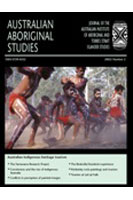Australian Aboriginal Studies: Issue 2, 2002
Abstracts for Issue 2, 2002
Re-figuring Bradshaw: art, place and landscape in the Victoria River District
Andrew McWilliam
The emergence of legislation dealing with Aboriginal land rights, native title and cultural heritage protection has provided a range of prospective avenues for the recognition and protection of minority Indigenous land interests in Australia. This historic accommodation within state legislative structures has, in turn, fostered a renewed interest and desire among Aboriginal communities to reassert their links to ancestral country. Focusing on one area of the Northern Territory, this article explores aspects of cultural attachment and affiliation to land through the medium of the painted image and artistic representation of mythologised place.
Weapons and wunan: production, function and exchange of Kimberley points
Kim Akerman, Richard Fullagar and Annelou van Gijn
We describe the production, function and exchange of projectile points in the Kimberley region, northwestern Australia. Our aims are to identify problems in the interpretation of residues and use-wear, and to assess whether aspects of exchange can be inferred from microscopic study of these archaeological points. For the late prehistoric and contact periods, we identify change in production technique, artefact design and function. We also document microscopic traces (use-wear, resin, ochre, starch granules and apparent blood films) on glass, stone and ceramic points from museum collections and excavated artefacts. Although ethnography suggests that size and elaborate flaking may indicate production for exchange, we conclude that microscopic traces alone do not.
Aboriginal bark burial: 700 years of mortuary tradition in the Central Queensland Highlands
Scott L’Oste-Brown, Luke Godwin and Mike Morwood
There has been a long interest in the burial practices of the Central Queensland Highlands, most notably the burial of the deceased in often highly decorated bark coffins. This has led to considerable speculation as to the antiquity of this burial custom, with some suggesting that it is a recent response to European settlement and influences in the region from around the 1850s. In this article, we present a series of dates that provide, for the first time, some definitive insights into this question. We clearly show that this burial tradition is one of considerable antiquity that absolutely predates both the contact and settlement periods not only within the region but for Australia as a whole. We also explore the factors that are responsible for the long-term survival of these funerary objects. Finally, the implications of the antiquity of these dates and the continuity and maintenance of cultural traditions within the context of native title are also discussed.
Geophagy: an assessment of implications for the development of Australian Indigenous plant processing technologies
M.J. Rowland
The practice of geophagy, in particular the consumption of clay and charcoal by humans, is global in its distribution, is of considerable antiquity and has a number of complex functions. One of these functions is the ability of clays and charcoals to adsorb toxins. This has been known anecdotally for some time and has more recently been scientifically demonstrated. This article reviews evidence that indicates that the adsorptive qualities of clays were well recognised by Indigenous Australians. This Indigenous knowledge therefore has significant implications for the timing and nature of adaptation to many of the toxic plants of Australia. It is proposed that knowledge of these adsorptive qualities arrived with the earliest colonisers and enabled them to adapt to toxic plants earlier and more easily than has usually been assumed.
Sociospatial structures of Australian Aboriginal settlements
Paul Memmott
This article is concerned with the ‘sociospatial patterns’ of Australian Aboriginal settlements, which are herein defined as the division of settlements into spatial zones, each occupied by an aggregate of domiciliary groups and possessing some common social identity and characteristic social structure. It is argued that sociospatial structures occurred in large Aboriginal camps across the continent to facilitate various social functions. Drawing on 15 case studies in the anthropological literature which were researched between 1896 and 1988, the analysis considers the following principles as explanations or generating devices for sociospatial settlement patterns: kinship and economy, sociogeographic identity, class divisions, and the locational principle of camping in the direction of one’s country.
Are such patterns being maintained under conditions of cultural change and sedentarisation? If so, how important is it to acknowledge and preserve these patterns? It is argued that the continuity of a sociospatial structure in an Aboriginal community enables traditional social groups to maintain distinct residential locations in relation to one another, which in turn contributes to the maintenance of a variety of customary behavioural features, including social identity and internal social control.
